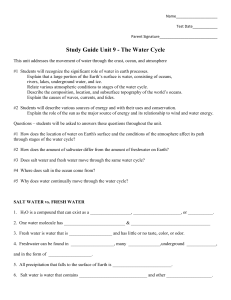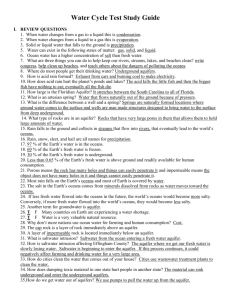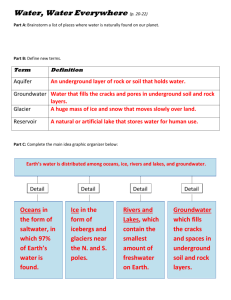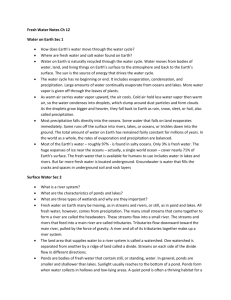Study Guide Unit 9 - The Water Cycle
advertisement
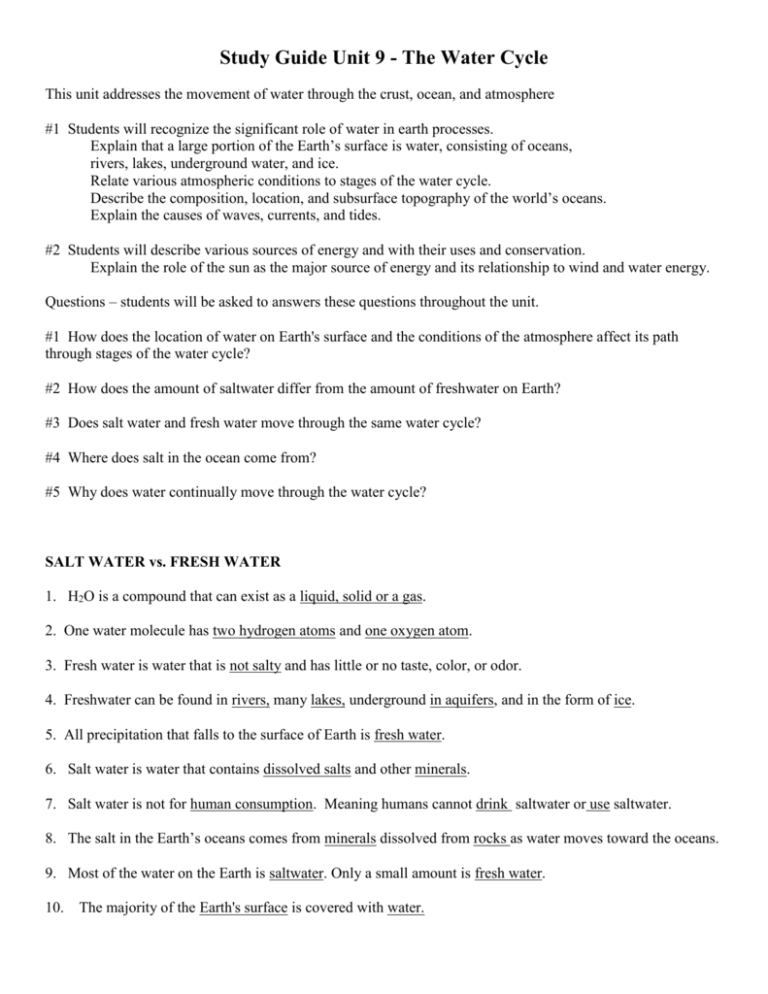
Study Guide Unit 9 - The Water Cycle This unit addresses the movement of water through the crust, ocean, and atmosphere #1 Students will recognize the significant role of water in earth processes. Explain that a large portion of the Earth’s surface is water, consisting of oceans, rivers, lakes, underground water, and ice. Relate various atmospheric conditions to stages of the water cycle. Describe the composition, location, and subsurface topography of the world’s oceans. Explain the causes of waves, currents, and tides. #2 Students will describe various sources of energy and with their uses and conservation. Explain the role of the sun as the major source of energy and its relationship to wind and water energy. Questions – students will be asked to answers these questions throughout the unit. #1 How does the location of water on Earth's surface and the conditions of the atmosphere affect its path through stages of the water cycle? #2 How does the amount of saltwater differ from the amount of freshwater on Earth? #3 Does salt water and fresh water move through the same water cycle? #4 Where does salt in the ocean come from? #5 Why does water continually move through the water cycle? SALT WATER vs. FRESH WATER 1. H2O is a compound that can exist as a liquid, solid or a gas. 2. One water molecule has two hydrogen atoms and one oxygen atom. 3. Fresh water is water that is not salty and has little or no taste, color, or odor. 4. Freshwater can be found in rivers, many lakes, underground in aquifers, and in the form of ice. 5. All precipitation that falls to the surface of Earth is fresh water. 6. Salt water is water that contains dissolved salts and other minerals. 7. Salt water is not for human consumption. Meaning humans cannot drink saltwater or use saltwater. 8. The salt in the Earth’s oceans comes from minerals dissolved from rocks as water moves toward the oceans. 9. Most of the water on the Earth is saltwater. Only a small amount is fresh water. 10. The majority of the Earth's surface is covered with water. 11. The water on Earth is not evenly distributed. Most of it is unsuitable for drinking. 12. The total volume of water on the Earth is 326 million cubic miles. 13. 97% of Earth’s water is in the oceans as salt water. 14. 3% of Earth’s water is fresh water. 15. 2% of Earth’s water is frozen in ice caps and glaciers. 16. Less than 1% (0.65%) of Earth’s water is fresh water in lakes, streams, groundwater, and water vapor in the atmosphere. WATER CYCLE 17. H2O (water) cycles through states of matter in the atmosphere based on atmospheric conditions. 18. The water cycle has three stages: precipitation, evaporation, and condensation 19. The process in which water changes from liquid to vapor is called evaporation. 20. Transpiration is the evaporation of water from plants. 21. Condensation is the process in which water vapor in the atmosphere becomes liquid. 22. When water falls from clouds as liquid or solid it is called precipitation. 23. The cycling of water in and out of the atmosphere plays an important role in determining climatic patterns. 24. Water evaporation from the surface of the earth, rises and cools, condenses into rain or snow, and falls again to the surface. 25. Rain, snow, sleet, and hail are all for precipitation. 26. Rain falls to the ground and collects in streams that flow into rivers, that eventually lead to the world’s oceans. 27. The water, which is a solvent, falling on land collects in rivers and lakes, soil, and porous layers of rock, and much of it flows back into the ocean. 28. Most rain falls on the Earth’s oceans because most of Earth is covered by water. 29. Most of the water that evaporates on Earth, evaporates from the ocean. The salt and minerals are left behind in the ocean. 30. Salts have become concentrated in the sea (compared with freshwater) because the sun's heat causes the evaporation of water, leaving the salts and minerals behind. 31. If less fresh water flowed into the oceans in the future, the world’s oceans would become more salty. 32. If more fresh water flowed into the world’s oceans, they would become less salty. GROUNDWATER 33. 2% of Earth’s total water is frozen in ice caps and glaciers. 34. Less than 1% (0.65%) of Earth’s water is fresh water in lakes and streams, groundwater, and water vapor in the atmosphere. 35. Most of the freshwater on Earth is located in glaciers and ice caps. 36. Groundwater is water that occurs as a liquid resource that is dispersed through innumerable holes, pores, fractures and cavities in bodies of rock or sediment. 37. Porous means the rock has many pores and things can easily penetrate it. 38. When something is impermeable then water cannot easily penetrate it. 39. An aquifer is an underground layer of permeable rock or sediment that contains water. 40. A layer of impermeable rock is located immediately below an aquifer. 41. A layer of permeable rock is located above an aquifer. 42 Aquifers have rocks that have very large pores in them. This allows them to hold large amounts of water. 43. How do we get water out of aquifers? Pumps pull the water up from the aquifer. 44. What is saltwater intrusion? Saltwater from the ocean entering a fresh water aquifer. 45. A geyser is formed when heat from magma heats water and forces it to shoot out of the ground. 46. Water in an artesian spring flows naturally out of the ground because of pressure. 47. Springs are naturally formed locations where ground water comes to the surface and wells are man-made structures designed to bring water to the surface from deep underground. WATER – THE IMPORTANT RESOURCE 48. Human have access to use less than one percent of the water on Earth for drinking and personal hygiene. 49. This less than one percent is also used for agriculture, fisheries, transportation, heating and cooling, manufacturing, and many other purposes. 50. Unless humans use freshwater wisely, rivers, lakes, and groundwater can become depleted or polluted, and unavailable or unsuitable for life. 51. Much of our municipal and industrial water comes out of the ground. 52. Many countries on Earth are experiencing a fresh water shortage. 53. Water is a valuable natural resource. 54. Air pollution causes acid rain. Rainwater picks up particles and gases when it falls through the air. If the air is polluted, the rainwater becomes polluted too. 55. The acid rain can kill fish and plant life in lakes, rivers, and ponds. 56. Where do most people get their drinking water? Underground aquifers. 57. The Floridian Aquifer stretches from Florida and South Carolina. 58. Why is the Floridian Aquifer important to ME? Most residents of Georgia get their drinking water from the Floridian Aquifer. 59. Why is it unwise to drink from streams and rivers? Microscopic plants and animals live in the water and can cause humans serious illnesses and can lead to death. 60. How do cities clean the water that comes out of your house? Cities use wastewater treatment plants to clean the water. 61. How does dumping toxic material in one state hurt people in another state? The material can sink underground and enter the underground aquifers. 62. Why don’t more nations use ocean water for farming and human consumption? Cost of purifying it to become fresh is too expensive. VOCABULARY The Water Cycle - Continuous movement of water on Earth, through the atmosphere and in the living things on Earth. deposition – the part of the erosion process in which sediment is placed in a new location erosion – the process in which weathered particles are picked up and moved from one place to another gravity – the natural force that tends to cause physical things to move toward each other - the force that caused things to fall toward Earth composition - the nature of something's ingredients or constituents; the way in which a whole or mixture is made up conservation - preservation, protection, or restoration of the natural environment, natural ecosystems, vegetation, and wildlife evaporation - process in which water changes from liquid to vapor condensation - process in which vapor in the atmosphere becomes liquid precipitation – water that falls from clouds transpiration – evaporation of water from plants impermeable - will not allow water to pass through permeable - allowing the passage of water aquifer - an underground layer of permeable rock or sediment that contains water water table - highest part in the ground that is completely filled with water
